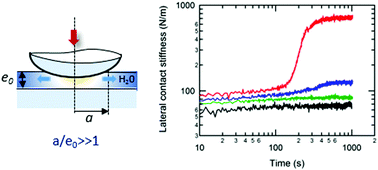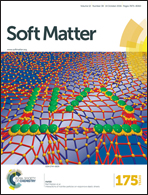Poroelastic indentation of mechanically confined hydrogel layers†
Abstract
We report on the poroelastic indentation response of hydrogel thin films geometrically confined within contacts with rigid spherical probes of radii in the millimeter range. Poly(PEGMA) (poly(ethylene glycol) methyl ether methacrylate), poly(DMA) (dimethylacrylamide) and poly(NIPAM) (N-isopropylacrylamide) gel films with thickness less than 15 μm were grafted onto glass substrates using a thiol–ene click chemistry route. Changes in the indentation depth under constant applied load were monitored over time as a function of the film thickness and the radius of curvature of the probe using an interferometric method. In addition, shear properties of the indented films were measured using a lateral contact method. In the case of poly(PEGMA) films, we show that poroelastic indentation behavior is adequately described within the framework of an approximate contact model derived within the limits of confined contact geometries. This model provides simple scaling laws for the characteristic poroelastic time and the equilibrium indentation depth. Conversely, deviations from this model are evidenced for poly(DMA) and poly(NIPAM) films. From lateral contact experiments, these deviations are found to result from strong changes in the shear properties as a result of glass transition (poly(DMA)) or phase separation (poly(NIPAM)) phenomena induced by the drainage of the confined films squeezed between the rigid substrates.


 Please wait while we load your content...
Please wait while we load your content...